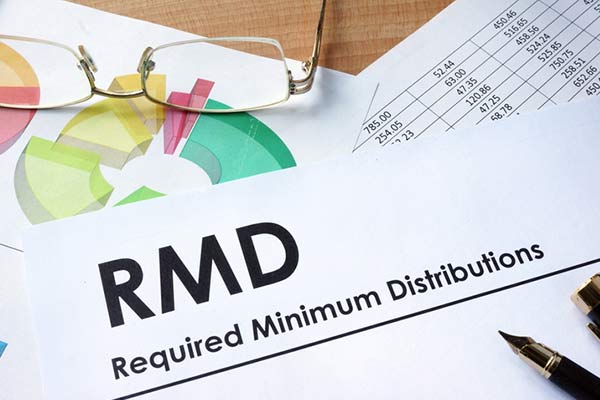Need to Know: Required Minimum Distributions (RMDs)
What Is a Required Minimum Distribution (RMD)?
A required minimum distribution (RMD) is a mandatory annual withdrawal that you must take from certain types of tax-advantaged retirement plans. If you don’t take your RMDs in time, you could have to pay a steep 50% tax on the money you should have withdrawn. However, the amount you’re required to withdraw can change each year because it depends on your age and the account’s balance.
Which Accounts Require RMDs?
The RMD rules can vary depending on the type of retirement plan. For example, Roth IRAs don’t have any RMDs—which is one reason they can be an important part of retirement planning.
But generally, you’ll have to take RMDs if you have one or more of the following types of plans:
- 401(k) plans
- 403(b) plans
- 457(b) plans
- Profit-sharing plans
- Defined contribution plans
- Traditional IRAs, SEP IRAs, SIMPLE IRAs, and SARSEPs
You also must take RMDs from Roth 401(k) plans, but you won’t have to if you roll the Roth 401(k) into a Roth IRA.
The money you withdraw is taxable income for the year if it comes from a pre-tax account, such as a 401(k) plan. However, required Roth 401(k) withdrawals aren’t taxable as you contributed to the plan with post-tax funds.
When Do You Have to Take Your RMDs?
Generally, you’ll have to withdraw your full RMD amount before Dec. 31 of each year. You can do this with one lump-sum withdrawal, or spread the withdrawals throughout the year.
The timing for your first RMD is a little trickier to figure out as it can depend on what types of retirement plans you have, when you retire, and when you turn 70 ½.
Often, your first RMD has to be taken out by April 1 of the calendar year after you turn 70 ½.
For example, if you turn 70 on Jan. 1, 2020, then you’ll be 70 ½ in 2020 and must take your RMD for 2020 by April 1, 2021.
But if you turn 70 on July 1, 2020, you’ll be 70 ½ in 2021 and must take your RMD for 2021 by April 1, 2022.
Some retirement plans give you the option to wait until April 1 of the year after you retire, but check your plan’s specifics because they’re not required to do so.
Additionally, for IRAs (including SEPs, SIMPLEs, and SARSEPs) and defined contribution plans, if you own (or owned) 5% or more of the business that sponsors the plan, you have to take the RMD by April 1 of the year after you turn 70 ½ regardless of when you retire.
The IRS has a chart that compares some of the rules, including timing, for IRAs and defined contribution plans.
Remember that each of your accounts may have its own rules and timelines, and you might have to start taking RMDs from some retirement plans even if others let you delay withdrawals until after you retire. Also, know that different rules apply to 403(b) plans from before 1987, and you can read more about those on the IRS’s website.
Calculating and Withdrawing Your RMDs
Your RMD amount depends on the balance in the retirement plan on Dec. 31 of the previous year and your age.
Each year, the IRS publishes the required minimum distribution tables, or uniform lifetime tables, and worksheets you can use to determine your RMD. However, there are also online calculators that will do the calculations for you.
One thing to keep in mind is that each of your retirement plans can have a separate RMD, and you’ll need to withdraw the sum of your RMDs to avoid the 50% excise tax on undistributed funds.
- For IRAs, you can calculate the sum of your RMDs and then withdraw the money from one or more of your retirement plans. The same rule applies to 403(b) plans.
- For other defined contribution plans, you must calculate the RMD for each plan and withdraw that amount from the associated account.
- Even if you file a joint tax return, each spouse has to take his or her RMDs from their individual accounts.
If you want or need, you can also withdraw more than the minimum, but excess withdrawals don’t roll over to lower your RMD next year.
A Few More Tips to Keep in Mind
We’ve covered the basics for required minimum distributions, but RMDs can be a complex part of retirement planning—especially if you have multiple retirement plans and sources of income in retirement.
Here are a few additional tips to keep in mind:
- Different RMD rules apply if you’re the beneficiary of a retirement plan.
- You can spend the RMD funds as you please, but you can’t contribute the money back into a qualified retirement plan.
- You may have to take two RMDs during the first year you take an RMD. For example, if you turn 70 ½ during the second half of 2020, you might not have to take your RMD for 2021 until April 1 of 2022. However, you also need to take your RMD for 2022 during 2022.
- If you have an IRA, a qualified charitable distribution (QCD) can count toward your RMD and be a tax-efficient way to support charitable causes. With a QCD, you can donate cash or investments directly to the charity and won’t have to include the funds in your taxable income.
- If you didn’t take your RMDs, or didn’t withdraw enough money, and you’re trying to correct the mistake, the IRS may waive some or all of the excise tax.
As always, you may want to work with an accountant if you have specific questions about your individual situation. If you’d like to learn more about retirement planning in general, the Quicken Blog has an entire section focused on retirement.
Quicken has made the material on this blog available for informational purposes only. Use of this website constitutes agreement to our Terms of Use and Privacy Policy. Quicken does not offer advisory or brokerage services, does not recommend the purchase or sale of any particular securities or other investments, and does not offer tax advice. For any such advice, please consult a professional.



